Ritual purification
This article needs additional citations for verification. (November 2019) |

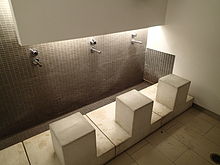
Ritual purification is a ritual prescribed by a religion through which a person is considered to be freed of uncleanliness, especially prior to the worship of a deity, and ritual purity is a state of ritual cleanliness. Ritual purification may also apply to objects and places. Ritual uncleanliness is not identical with ordinary physical impurity, such as dirt stains; nevertheless, body fluids are generally considered ritually unclean.
Most of these rituals existed long before the
Some have seen benefits of these practices as a point of health and preventing infections especially in areas where humans come in close contact with each other. While these practices came before the idea of the germ theory was public in areas that use daily cleaning, the destruction of infectious agents seems to be dramatic.[dubious ][1] Others have described a 'dimension of purity' that is universal in religions that seeks to move humans away from disgust (at one extreme), to uplift them towards purity and divinity (at the other extreme), away from uncleanliness to purity, and away from deviant to moral behavior (within one's cultural context).[2]
Baháʼí Faith
In the
These ablutions have a significance beyond washing and should be performed even if one has bathed oneself immediately before reciting the obligatory prayer; fresh ablutions should also be performed for each devotion, unless they are being done at the same time. If no water (or clean water) is available or if an illness would be worsened by the use of water, one may instead repeat the verse "In the Name of God, the Most Pure, the Most Pure" five times before the prayer.[3]
Apart from this, Bahá'u'lláh abolished all forms of ritual impurity of people and things, following Báb who stressed the importance of cleanliness and spiritual purity.[4]
Buddhism

In
This type of ritual cleansing is the custom for guests attending a tea ceremony[5] or visiting the grounds of a Buddhist temple.[6] The name originates from the verb tsukubau meaning "to crouch"[7] or "to bow down", an act of humility.[6] Guests attending a tea ceremony crouch and wash their hands in a tsukubai set in the tea garden before entering the tearoom.[7]
Tsukubai are usually of stone, and are often provided with a small ladle, ready for use.[7] A supply of water may be provided via a bamboo pipe[7] called a kakei.
The famous tsukubai shown here stands in the grounds of the Ryōan-ji temple in Kyoto, and was donated by the feudal lord Tokugawa Mitsukuni.[8] The kanji written on the surface of the stone are without significance when read alone. If each is read in combination with 口 (kuchi) - the shape of the central bowl - then the characters become 吾, 唯, 足, 知 which translates literally as "I only know plenty" (吾 = ware = I, 唯 = tada = only, 足 = taru = plenty, 知 = shiru = know).[9] The underlying meaning, variously translated as "what one has is all one needs",[9] or "learn only to be content"[8] reflects the basic anti-materialistic teachings of Buddhism.
Christianity
The
The
Many ancient churches were built with a large fountain in the courtyard. It was the tradition for Christians to wash before entering the church for worship.
The principle of washing the hands before celebrating the holy Liturgy began as a practical precaution of cleanness, which was also interpreted symbolically.
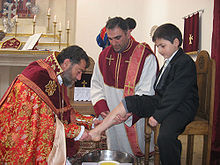
Traditionally, Christianity adhered to the biblical regulation requiring the purification of women after childbirth; this practice, was adapted into a special ritual known as the
A
In Reformed Christianity,
The
Hinduism
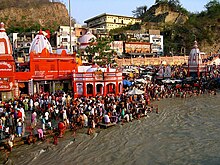
Various traditions within Hinduism follow different standards of ritual purity and purification. Within each tradition the more orthodox groups follow stricter rules, but the strictest rules are generally prescribed for Brahmins, especially those engaged in the temple worship.
An important part of ritual purification in Hinduism is the bathing of the entire body, particularly in rivers considered holy such as the Ganges. It is considered auspicious to perform this method of purification before festivals after a death, in order to maintain purity.
Punyahavachanam is a ritual meant to purify one's self and one's home, usually performed before important occasions, like weddings. During the ceremony, mantras are chanted and then consecrated water is sprinkled over all of the participants and the items used.
In the ritual known as
Sūtak are
There are various kinds of purificatory rituals associated with death ceremonies. After visiting a house where a death has recently occurred, Hindus are expected to take baths.
Women take a head bath after completing their four-day
Indigenous American religions
In the traditions of many
Yuquot Whalers' Shrine on Vancouver Island was used by chiefs to prepare ritually for whaling.
Islam
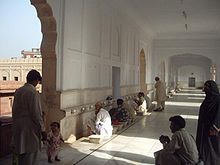
Islamic ritual purification is particularly centred on the preparation for salah, ritual prayer; theoretically ritual purification would remain valid throughout the day, but is treated as invalid on the occurrence of certain acts, flatulence, sleep, contact with the opposite sex (depending on which school of thought), unconsciousness, and the emission of blood, semen, or vomit. Some schools of thought mandate that ritual purity is necessary for holding the Quran.
Ritual purification takes the form of ablution, wudu and ghusl, depending on the circumstance; the greater form is obligatory by a woman after she ceases menstruation, on a corpse that did not die during battle, and after sexual activity, and is optionally used on other occasions, for example just prior to Friday prayers or entering ihram.
An alternative tayammum ("dry ablution"), involving clean sand or earth, is used if clean water is not available or if an illness would be worsened by the use of water; this form is invalidated in the same circumstances as the other forms, and also whenever water becomes available and safe to use.
The fard or "obligatory activities" of the lesser form include beginning with the intention to purify oneself, washing of the face, arms, head, and feet. while some mustahabb "recommended activities" also exist such as basmala recitation, oral hygiene, washing the mouth, nose at the beginning, washing of arms to the elbows and washing of the ears at the end; additionally recitation of the Shahada. The greater form (ghusl) is completed by first performing wudu and then ensuring that the entire body is washed. Some minor details of Islamic ritual purification may vary between different madhhabs "schools of thought".
Judaism

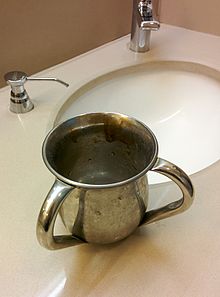
The
These regulations were variously observed by the ancient Israelites. Purification was required in ancient times, so that ritually impure individuals would not defile God's tabernacle and receive the punishments of death or kareth.[38] Nowadays, in the absence of the Temple in Jerusalem, many of the Torah's laws about purification have no practical implication and are no longer observed. However, purification from the niddah status is still observed by contemporary Orthodox Jews and (with some modifications and additional leniencies) some Conservative Jews, as its practical implications are highly relevant: a woman who is impure with this status is forbidden to have sexual contact with her husband.
Mandaeism
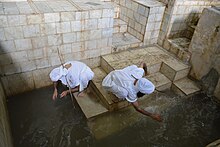
One of the most important ceremonies in Mandaean worship is baptism (masbuta). Unlike in Christianity, baptism is not a one-off event but is performed every Sunday, the Mandaean holy day, as a ritual of purification. Baptism usually involves full immersion in flowing water, and all rivers considered fit for baptism are called yardena (after the River Jordan). After emerging from the water, the worshipper is anointed with holy sesame oil (misha) and partakes in a communion of sacramental bread (pihta) and water. Other rituals for purification include the rishama and the tamasha which, unlike masbuta, can be performed without a priest.[41] The rishama (signing) is performed before prayers and involves washing the face and limbs while reciting specific prayers. It is performed daily, before sunrise, with hair covered and after evacuation of bowels or before religious ceremonies[42] (see wudu). The tamasha is a triple immersion in the river without a requirement for a priest. It is performed by women after menstruation or child birth, men and women after sexual activity or nocturnal emission, touching a dead corpse or any other type of defilement[42] (see tevilah). Ritual purification also applies to fruits, vegetables, pots, pans, utensils, animals for consumption and ceremonial garments (rasta).[42] Purification for a dying person is also performed. It includes bathing involving a threefold sprinkling of river water over the person from head to feet.[42]
Shinto
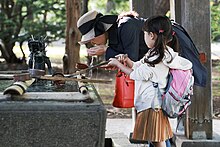
Ritual cleanliness is a central part of Shinto life.[43] In Shinto, a common form of ritual purification is misogi,[44][45] which involves natural running water, and especially waterfalls. Rather than being entirely naked, men usually wear Japanese loincloths and women wear kimono, both additionally wearing headbands.[44][45]
Western esotericism
In
In the
In
See also
- Bathing the dead
- Churching of women
- Eleusinian Mysteries
- Lady Macbeth effect
- Law of contagion
- Lustral basin
- Water and religion
References
Citations
- ^ "Nitten Soji and the prevention of infections" Classical fighting arts vol 2 #18
- ^ Haidt, Johnathan (12 February 2010). The Happiness Hypothesis. Basic Books.
- ^ ISBN 1-85168-184-1.
- ISBN 1-85168-184-1.
- ISBN 4-533-00528-4.
- ^ ISBN 4-89704-202-X.
- ^ OCLC 23738000.
- ^ ISBN 4-89704-202-X.
- ^ a b "Tsukubai and Zenibachi, the Japanese Water Basins". Retrieved 3 March 2016.
- ISBN 978-1-4411-6767-5.
- ISBN 9780761835011.
The Ethiopian and Coptic Churches distinguishes between clean and unclean meats, observes days of ritual purification, and keeps a kind of dual Sabbath on both Saturday and Sunday.
- ^ a b Mary Cecil, 2nd Baroness Amherst of Hackney (1906). A Sketch of Egyptian History from the Earliest Times to the Present Day. Methuen. p. 399.
Prayers 7 times a day are enjoined, and the most strict among the Copts recite one of more of the Psalms of David each time they pray. They always wash their hands and faces before devotions, and turn to the East.
{{cite book}}: CS1 maint: numeric names: authors list (link) - ^ Dawood, Bishoy (8 December 2013). "Stand, Bow, Prostrate: The Prayerful Body of Coptic Christianity". The Clarion Review. Retrieved 6 August 2020.
Standing facing the East is the most frequent prayer position. ... This is further emphasized in the fact that Copts pray facing the East, waiting for the return of Jesus in glory; his return as the enthroned Pantocrator is portrayed in the iconography that is placed before the worshippers.
- ^ Is THE CHURCH OF ETHIOPIA A JUDAIC CHURCH ?
- ^ The Liturgy of the Ethiopian Orthodox Tewahedo Church
- ^ ISBN 9780664502324. Retrieved 11 April 2009.
Maundy Thursday (or le mandé; Thursday of the Mandatum, Latin, commandment). The name is taken from the first few words sung at the ceremony of the washing of the feet, "I give you a new commandment" (John 13:34); also from the commandment of Christ that we should imitate His loving humility in the washing of the feet (John 13:14–17). The term mandatum (maundy), therefore, was applied to the rite of foot-washing on this day.
- ^ John 13:1–17
- ^ The Holy Rule of St. Benedict
- ISBN 9780838633915.
- ISBN 9781441167675.
- ^ Fortescue, Adrian. "Lavabo." The Catholic Encyclopedia Vol. 9. New York: Robert Appleton Company, 1910. 12 July 2017
- ^ Report of the Royal Commission on Ecclesiastical Discipline (Church of England) 1906
- ^ ISBN 978-1-4411-6767-5.
It was probably out of the Jewish rite that the practice developed among early Christians, especially in the east, of washing their hands and feet before going into church. Early Christian basilicas had a fountain for ablutions, known as cantharus or phiala, and usually placed in the centre of the atrium. They are still found in some Eastern Orthodox churches, notably at the monastery of Laura at Mount Athos, where the phiala is an imposing structure in front of the entrance covered by a dome resting on eight pillars. In several Orthodox churches today worshippers take off heir shoes and wash their feet before entering the church just as Muslims do before going into a mosque.
- ^ a b c Soloviĭ, Meletiĭ M. (1970). Eastern Liturgical Theology: General Introduction. Ukrainian Catholic Religion and Culture Society of Etobicoke (Toronto) and Ukrainian Catholic Youth of Canada. p. 68.
In the Book of Exodus (30, 18-20) Aaron and his sons were required to wash before approaching the altar. Here water is used as a symbol of purification and expiation. But water is also the most common and most indispensable drink. ... So much was the practice a part of the life of the early Church, that in the period after Constantine the "cantharus", or water fountain, became a standard fixture in the courtyard before the basilica to permit the faithful to purify themselves before entering the presence of God.
- ^ a b c Bingham, Joseph (1840). The antiquities of the Christian Church. W. Straker. p. 396.
In the middle of which stood a Fountain for washing as they entered into the Church, called Cantharus and Phiala in some authors. It is further to be noted, that in the middle of the atrium, there was commonly a fountain, or a cistern of water, for people to wash their hands and face, before they went into the church.
- ^ ISBN 978-1-136-61158-2.
- ^ Lowrie, Walter (1901). Christian Art and Archæology: Being a Handbook to the Monuments of the Early Church. Macmillan Publishers. p. 179.
In the middle of this court there was as a rule a fountain of running water (the cantharus) for the symbolical purification of those who ere about to enter the church.
- ^ Smith, Bertha H. (1909). "The Bath as a Religious Rite among Mohammedans". Modern Sanitation. 7 (1). Standard Sanitary Mfg. Co.
The Copts, descendants of these ancient Egyptians, although Christians, have the custom of washing their hands and faces before prayer, and some also wash their feet.
- ^ Tadros, Emile (2015). Reconstruction the Origins of the Coptic Church through its Liturgy. McMaster Divinity College. p. 16.
The Coptic Church observes strict practices concerning circumcision, rituals surrounding menstruation, weekly two-days fasting, 40 ablution, and many other rituals.
- ISBN 9780721625973.
- ISBN 9780721625973.
Douching is commonly practiced in Catholic countries. The bidet ... is still commonly found in France and other Catholic countries.
- ISBN 978-8866490395.
- ^ "Bidets in Finland"
- ^ "印度教".
- ^ Textbook of the 'University of Spirituality', Volume 61, Death and Post-Death Rites, by Parātpar Guru (Dr) Athavale and H.H. (Mrs.) Anjali http://sanatanshop.com/shop/en/booklets/383-death-and-post-death-rites.html
- ^ The Sacred Formulas of the Cherokee by James Mooney 1891
- ^ The History of The American Indians by James Adair 1775
- ^ Leviticus 15:31; Numbers 19:20
- ISBN 0-9644279-6-6. Retrieved 11 April 2015.
- ^ Rutta, Matt (30 March 2008). "Shemini/Parah (The smell of burning death)". Rabbinic Rambling. Retrieved 6 May 2009.
- ^ Drower, Ethel Stefana. The Mandaeans of Iraq and Iran. Oxford At The Clarendon Press, 1937
- ^ a b c d Mandaean Awareness and Guidance Board (28 May 2014). "Mandaean Beliefs & Mandaean Practices". Mandaean Associations Union. Retrieved 13 November 2021.
- ISBN 0-8048-3557-8
- ^ a b Bocking 1997, p. 93; Cali & Dougill 2013, p. 20.
- ^ a b Nelson 1996, p. 101; Bocking 1997, p. 45; Cali & Dougill 2013, p. 21.
- ^ a b Crowley, Aleister. Magick in Theory and Practice. pp. 103–6.
- ^ The Golden Dawn by I. Regardie
- ^ "Golden Dawn Neophyte Knowledge Lecture". Retrieved 7 May 2011.
- ^ Crowley, Aleister. Liber Aleph vel CXI. A.:.A.:.
- ^ Konstantinos.Nocturnal Witchcraft: Magick After Dark. St. Paul, Minn:Llewellyn Publications, 2002.
Sources
 This article incorporates text from a publication now in the public domain: Herbermann, Charles, ed. (1913). "Lavabo". Catholic Encyclopedia. New York: Robert Appleton Company.
This article incorporates text from a publication now in the public domain: Herbermann, Charles, ed. (1913). "Lavabo". Catholic Encyclopedia. New York: Robert Appleton Company.- Bocking, Brian (1997). A Popular Dictionary of Shinto (revised ed.). Richmond: Curzon. ISBN 978-0-7007-1051-5.
- Cali, Joseph; Dougill, John (2013). Shinto Shrines: A Guide to the Sacred Sites of Japan's Ancient Religion. Honolulu: University of Hawai'i Press. ISBN 978-0-8248-3713-6.
- Nelson, John K. (1996). A Year in the Life of a Shinto Shrine. Seattle and London: University of Washington Press. ISBN 978-0-295-97500-9.
External links
 Media related to Water in religion at Wikimedia Commons
Media related to Water in religion at Wikimedia Commons
